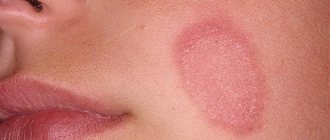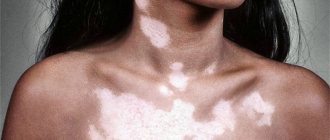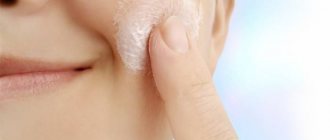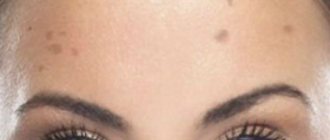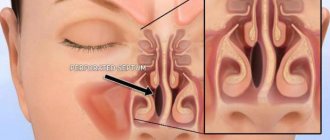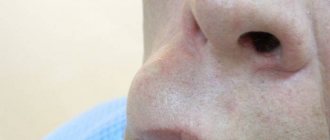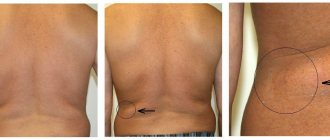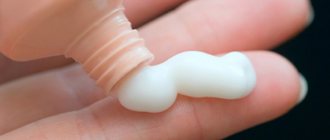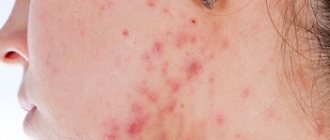Reasons for the appearance of molluscum contagiosum on the face
The causative agent of the disease is Molluscum contagiosum. It is viral in nature, contains DNA and belongs to the group that includes the smallpox virus. There are 4 types of molluscum contagiosum, designated MCV 1, 2, 3 and 4.
Infection occurs through contact (through household items, clothing, bed linen, towels, toys, when swimming in the pool) and through sexual contact. The liquid contents of the papular rash spread in the environment and can lead to infection of other people.
Molluscum contagiosum virus can survive on dust particles for a long time. This leads to widespread spread of the disease in children's groups. The development of the disease is facilitated by infrequent and insufficiently thorough cleaning of premises, neglect of personal hygiene rules, decreased immunity, long-term use of cytostatics and hormonal drugs.
If left untreated, a papular rash on the face or other parts of the body lasts 6–8 months, in some cases up to 4 years, and then may disappear.
The virus does not cause significant harm to the body. But with a weakened immune system, relapses of the disease may occur and become chronic.
To date, there are no medications that can completely destroy DNA-containing viruses. Therapy aimed at strengthening the immune system helps prevent relapses of molluscum contagiosum.
Since epithelioma is contagious and occurs in people with a deficiency of immunity, there is a very high probability of the body being affected by other infections, for the detection of which it is necessary to undergo additional examination.
Symptoms
Neoplasms can appear on any part of the face. Most often, molluscum contagiosum occurs on the eyelid or chin. They look like this:
- these are nodules slightly raised above the surface of the epidermis;
- are distinguished by a clear hemispherical shape;
- the color practically does not differ from the main skin tone, often slightly pinkish;
- in the center of the hemisphere you can see a small depression, an indentation;
- the size can be different: from small (1 mm) to large (1 cm);
- When pressed, a cheesy liquid is released from the nodule.
Features of molluscum contagiosum on the face include the following:
- the incubation period ranges from 3 weeks to 1.5 months;
- the number of rashes usually ranges from 1 to 10;
- does not cause pain or discomfort;
- only when the papules are filled with liquid can a slight feeling of burning and itching occur;
- there are no consequences or complications;
- in most cases disappears spontaneously after six months;
- After this, you need to regularly carry out preventive measures, otherwise the virus may return.
On the one hand, it is good that molluscum contagiosum on the skin does not require special therapy, since it disappears on its own without a trace. On the other hand, waiting a whole six months until your face is cleared of these unpleasant, albeit painless, warts is a very long time. Therefore, I can’t wait to find out how to treat this skin pathology, if such methods are already familiar to modern medicine.
About diagnostics. After a visual examination, the dermatologist usually takes a biopsy of the facial skin to confirm the diagnosis and determine what nature (malignant or benign) the tumors are.
Symptomatic manifestations of the disease
The duration of the incubation period for infection with molluscum contagiosum can be different - the minimum period for the development of the disease before the appearance of the first symptoms is 2 weeks, the maximum is 6 months. Invading epidermal cells, the virus integrates its genome into it, which leads to the reproduction of new intracellular parasites.
Visually, this process is the formation of papules on the skin - dense yellowish-pink nodules, shaped like hemispheres with a smooth and shiny surface. On the face, they most often appear on the skin of the eyelids and forehead; other places where the rash is localized are the neck, arms, thighs, lower abdomen, and external genitalia.
The rapid multiplication of the pathogen leads to an increase in the size of the rash. They can be located either in the form of single formations or in groups, the fusion of which leads to an expansion of the area of the affected skin areas up to 2–3 cm.
The upper part of the papules is slightly pressed inward and filled with white cheesy contents, which contain mollusc-shaped formations. Usually the rash is not painful; in rare cases, itching occurs. The inflammatory process appears when a secondary infection occurs.
Forms of the disease
Based on the symptomatic manifestations of molluscum contagiosum, three forms of the disease are distinguished: typical, generalized and complicated. In the first stage, there are few rashes, all the characteristic symptoms of the disease are manifested, the papules are located on one specific area of the body close to each other. With a generalized course of molluscum contagiosum, there are many neoplasms; they can be located at a considerable distance and in different parts of the body.
If the disease has progressed to a complicated stage, in addition to the main infection, a secondary one is added, which leads to inflammation and hyperemia of the skin surrounding the papules. In these areas, pus begins to secrete, causing pain.
This form of molluscum contagiosum is characteristic mainly of HIV-infected people. The spread of infection can occur during shaving, causing papules to appear on the chin.
The doctor talks about the causes, signs, and general symptoms of the manifestation of molluscum contagiosum on the skin of the face.
Causes
Molluscum contagiosum is a viral infection. The causes of these spherical papules on the face are common:
- direct contact with an already infected person;
- dirty hands;
- sexual intercourse with a carrier of the virus;
- water in baths, saunas, swimming pools;
- weak immunity;
- household unsanitary conditions;
- uncleanliness;
- failure to comply with personal hygiene rules;
- poor environmental situation.
Typically, molluscum contagiosum on the face rarely occurs in adults. But if this does happen, you need to be able to distinguish the disease in time from other similar rashes that will require a completely different approach. To do this, you need to have at least a little idea of the clinical picture of the pathology.
Origin of name. The disease received such an interesting name because the warts that form during its process are filled with a cheesy liquid. So scientists saw microbodies in it that vaguely resembled mollusks. And it is contagious because it is transmitted mainly through contact with the carrier of the virus.
Diagnostics
When making a diagnosis, the clinical picture of the disease is taken into account. If difficulties arise, for differential diagnosis with other diseases (lichen planus, syphilis, warts, chickenpox, allergic manifestations, tumors), a histological examination of the internal contents of the pustules is carried out under a microscope to detect molluscan bodies.
They form in the deep layers of the epithelium and, continuously multiplying, fill the affected skin cells.
Compared to the rash of molluscum contagiosum, papular syphilide does not have similar inclusions inside the papules. Chicken pox occurs with fever, headache, and itching in the area of the rash. The chickenpox rash appears as clear blisters filled with liquid. In severe cases, pus may accumulate in them.
Lichen ruber is characterized by the formation of light plaques with a pearlescent surface, but not filled with liquid contents inside. To make an accurate diagnosis, you should consult a dermatovenerologist.
Molluscum contagiosum - treatment in children with the most effective methods
Molluscum contagiosum is a type of viral dermatitis that often occurs in childhood.
Virus transmission occurs:
- in everyday life, during contact, during games - in the swimming pool and public baths
- upon skin contact with towels, toys, books that are already infected
The main question facing pediatricians is: how to treat molluscum contagiosum in children without injuring the skin or causing harm to their health.
What does molluscum contagiosum look like, the reasons for its appearance in children
After the appearance of a separate nodule, rapid spread of the disease is possible. The lesion itself appears in the form of a small white or pink semicircular papule (nodule), up to 5 – 6 mm. In the center of each node there is a small depression resembling a navel.
The disease is easily confused with rubella, chickenpox, measles, but there is one symptom that is a sign of this particular viral dermatitis - when you press on the tubercle, white contents appear from it, similar to a mushy granular mass, where the mollusks themselves are located.
The blisters appear as individual papules or entire rashes on the abdomen, head, thighs, neck, and limbs. Sometimes molluscum contagiosum forms entire clearings on a child’s face. Very rarely, nodules are observed on the palms and soles.
The main factors provoking the disease are:
- weakened immune system
- hot humid climate
You may also be interested in:
Course of the disease in children
The disease does not cause severe itching, pain or discomfort in the child. After a virus attack, the disease usually develops within 2 to 8 weeks. Final recovery occurs between 12 and 18 weeks.
In extremely rare cases, the disease lasts from a year to 4 years. In children, when fully mature, the mollusks look like convex pimples with a diameter of up to 8 mm. When drained, they form rashes and plaques.
Infection in 80% of 100 manifests itself before the age of 15, but is more often found in children under 4 years of age.
The disease may take the form:
- multiple rashes
- individual nodes up to 10 mm in diameter, sitting “on a leg”
- very large plaques in the form of growths that are formed by the fusion of small ones
Parents are always interested in how to get rid of molluscum contagiosum in children faster, but it is more important to control that children do not scratch the nodules and cause infection.
Molluscum contagiosum is not dangerous, and the rash disappears without treatment within a year, sometimes a year and a half. The introduction of infection into nodules combed by a child is dangerous.
How to treat molluscum contagiosum in children
Treatment of molluscum contagiosum in children has its own specifics and a direct connection with the immune system. It is believed that immunity to this disease develops very slowly in the child’s body, but gradually it will cope with the infection on its own within 2 months. For this reason, specialized treatment for molluscum contagiosum in children is not considered so necessary.
Therefore, if the child has been confirmed with this diagnosis after all the tests, doctors insist that they just need to wait until the disease inevitably goes away on its own without any treatment. It is also believed that antiviral drugs, suppositories, ointments and procedures do not speed up the recovery process.
But some doctors still insist that treatment is still necessary if the child’s immunity is reduced due to constantly occurring colds in children’s institutions, and that it will not cause harm, and the likelihood of a shorter recovery period increases. The result depends on the immune system, the age of the child and the area of the lesion.
Many methods that are shown to be very effective for adults are completely unsuitable for children.
External treatment of molluscum contagiosum in children using creams and ointments
Specialists are faced with the task of how to cure molluscum contagiosum in a child in the most gentle and at the same time effective ways.
This is precisely the treatment offered by antiviral ointments for children with molluscum contagiosum. One of the most common drugs is Viferon cream and Ifagel ointment, created on the basis of interferon, which strengthens the immune system, works as a powerful antiviral drug and has the following advantages:
- prevents infection of healthy tissues
- prevents the mollusk from entering a healthy cell
- disrupts the RNA of the virus itself in the blood
Viferon cream and Infagel ointment
Ointment for the treatment of molluscum contagiosum is applied in a thin layer to the rash up to 5 times a day (duration 7 days), being careful not to damage the papules. The interval between application procedures should not be more than 12 hours. There is no need to cover the area with the ointment applied, so that a medicinal film forms on the skin, which protects the papules, relieves swelling and possible itching.
Contraindications: hypersensitivity and intolerance to components. Age up to 1 year.
Acyclovir ointment
Ointments containing acyclovir, which have a strong antiviral effect, work well. Treatment of molluscum contagiosum with acyclovir is indicated for children from 3 months to 12 years - 5 mg per 1 kg of body weight. Contraindication: intolerance to the components.
Antiviral oxolinic ointment 3%
Treatment of molluscum contagiosum with oxolinic ointment: carefully lubricate the nodes and rashes 4 times a day, treatment period is 2 weeks (often the duration of treatment reaches 2 months). Only special sensitivity to oxolin is a contraindication.
https://www.youtube.com/watch?v=BUTS_mUcfAo
When using ointments, it is recommended to begin treatment when the first individual papules and bumps appear.
Attention! Doctors have many medications against this disease, however, their use is often contraindicated for children: Chronotan or Chlorophyllipt, which contain eucalyptus oil. Fluorouracil ointment, Retin-A, Aldara (Imiquimod), Verrukacid, Ferezol, Cycloferon are all ointments for adults.
Drug treatment
How to get rid of molluscum contagiosum using means to strengthen the child’s immunity? Various treatment methods are used, but immunomodulatory drugs will allow you to forget about the occurrence of relapses for a long time. These include:
Isoprinosine
- Antiviral agent, immunomodulator. Molluscum contagiosum is included in the class of use of this remedy.
- Contraindications: treatment with isoprinosine is not permitted for children under 3 years of age.
- Children over 3 years old (weighing up to 20 kg) – 50 mg per 1 kg of weight (per day). The dose is divided into 3–4 doses.
- If the child weighs more than 20 kg, the dose will be 1/2 tablet per 5 kilogram of weight per day.
- Treatment continues from 5 days until the last papule disappears. To prevent relapse, it can be used for up to 3 days.
Strengthening the child’s immune system is a prerequisite for getting rid of papules and rashes that develop precisely at moments when the immune system is weakened.
Candles Viferon 500000 IU2
- Children over 7 years old – 1 suppository 3 times a day for 5 – 12 days.
- Children under 7 years old – 1 suppository 2 times a day. You need to take a break between courses - 5 days.
Removing papules with tweezers and a Volkmann spoon
Papules should not be overdried or damaged. If a child touches a nodule, it is better to quickly cauterize it with brilliant green or iodine. But it should be remembered that molluscum contagiosum, being a viral infection, is resistant to alcohol antiseptics, which include iodine and brilliant green. With their help, only the infection that can get into the wound if it is damaged is eliminated.
One of the simple methods available at home is to remove molluscum contagiosum with tweezers. The contents of the papule are easily removed using tweezers with gentle pressure.
It is necessary to remove all the curdled mass until a small amount of blood appears. Then the nodule freed from mollusks is cauterized with hydrogen peroxide. For the purpose of possible relapse and prevention, the wounds are lubricated with oxolinic ointment for 4 days.
All nodules need to be removed until they completely disappear from the skin.
In addition to using tweezers, the papules are squeezed out and the contents are scraped out with a Volkmann spoon. Pain relief is provided with lidocaine spray. After the procedure, all wounds are lubricated with iodine.
Children do not really like the procedure using tweezers and a sharp spoon because it is unpleasant and painful. This must be taken into account.
Laser removal of papules
Modern equipment makes it possible to quickly remove molluscum contagiosum in children using a laser using local anesthesia. The use of laser compared to standard surgery has great advantages:
- adjacent tissues surrounding the nodules are not injured
- the process itself is carried out under completely sterile conditions
- After laser treatment, the disease rarely returns
- the procedure is completely bloodless and safe
- rapid healing of wounds
- short duration of the treatment process (several minutes)
After the laser procedure, you need to make sure that the child does not wet the wounds until they are completely dry.
Diathermocoagulation and cryotherapy
Molluscum contagiosum can be removed from a child through diathermocoagulation (cauterization of the papule with electric current). Cryotherapy will help get rid of nodes - an effective way to remove papules with liquid nitrogen.
The procedures of diathermocoagulation and cryotherapy are practically painless, but may be accompanied by unpleasant sensations, burning, tingling, so it is not advisable to use these types of treatment for children.
Folk remedies
The grass of succession, bird cherry, calendula, celandine and ordinary garlic works very well for the disease. Read more about how to treat molluscum contagiosum at home here.
- To prepare the infusion, measure 2 tablespoons of the string per glass of boiling water. Leave for 1 hour. Lubricate the nodules 5 times a day (duration 12 days).
- from fresh bird cherry and kept tightly closed in the cold. The juice is used to lubricate multiple rashes. It works very effectively after removing the contents of the nodules with tweezers. Wound healing occurs in a very short time.
- Gently lubricate the nodules garlic juice All areas with nodules should be treated to prevent the infection from spreading.
- Lubricating the papules with the juice of flowering celandine will relieve the child of molluscum contagiosum within seven days.
- Papules, without squeezing out their contents, are successfully treated with tincture of calendula , eucalyptus (up to 5 times a day).
Removing molluscum contagiosum with tweezers, the video will show whether this should be done or not.
Source: https://idermatolog.net/boleznikogi/kontagiozny-j-mollyusk-lechenie-u-detej.html
Treatment methods for molluscum contagiosum
In many cases, after accurately determining the type of disease, specialists do not prescribe drug therapy, since if the body is in good shape, all symptoms will go away on their own within 6 months. If the immune system is in a normal state, it will be possible to avoid relapses of molluscum contagiosum in the future without taking special medications.
But if the disease occurs against a background of reduced immunity, for example, when a person is infected with HIV, it becomes chronic and to prevent its recurrence it is necessary to constantly strengthen the immune system.
Use of general drug therapy
When choosing medications, the doctor takes into account the duration of the disease, age and health status of the patient. Immunomodulators (Amiksin, Cycloferon) and treatment of affected areas with antiviral ointments (Acyclovir, Oksolinovaya) are prescribed.
For the generalized form of molluscum contagiosum, accompanied by profuse rashes, tetracycline antibiotics (Doxycycline, Tetracycline, Metacycline) are used.
Removing papules using laser
When exposed to a laser beam, the skin layer at the site of the virus concentration heats up, its temperature rises to 150°C. This contributes to the complete destruction of the infection and the elimination of affected cells through evaporation. The penetration depth of laser radiation does not exceed 5 mm, which guarantees no adverse effects on the underlying tissue. The procedure is safe and can be performed on both adults and children.
Removal of rashes prevents pathogens from reaching other areas of the skin and the development of complications in the form of sepsis or a purulent process, ensures the sterility of the treated surface, and is painless.
After treatment, you should protect the areas of skin where the papules were removed from contact with water for 3 days. Visits to the pool and water procedures in the bathhouse are prohibited. You should not stay in the bright rays of the sun for a long time or visit a solarium.
How to treat using liquid nitrogen?
The cryodestruction method is based on exposing the papule to liquid nitrogen cooled to −170 °C. Freezing the internal contents of the rash leads to the destruction of the pathogen and the destruction of the tissue damaged by it.
The procedure is completely painless, eliminates damage to healthy areas of the skin, and is not accompanied by bleeding or scarring. The technique can be used to eliminate papules in children and does not require bandages or medication.
How to remove papules using electrocoagulation
Cauterization of nodules in spray coagulation mode using a variable frequency current allows you to destroy the bodies of molluscum contagiosum and the epidermal cells affected by them. Anesthesia of the affected areas during electrocoagulation is provided by local anesthesia. Upon completion of the procedure, a dry crust remains at the site of the papule; after healing of the wound surface, no scars remain.
Surgical curettage of the contents of papules using curettage
Used for minor rashes. The area of skin on which the procedure will be performed is lubricated with the anesthetic drug EMLA, which is a cream containing a mixture of anesthetics Prilocaine and Lidocaine, 1 hour before the removal of foci of infection. A sealed bandage is applied to the treated surface. After an hour, the anesthetic is washed off and the operation begins.
A double-sided curette (Volkmann spoon) is used to scrape out the contents of the papules. Instead, a wooden spatula with a pointed surface can be used.
In some cases, tweezers are used to remove the internal contents of the nodules. Then the surface of the skin is treated with iodine solution, Podophyllin or Chlorhexidine. During the procedure, bleeding may occur, and scars sometimes form on the wounds.
Removing papules using chemicals
The method consists of regular daily lubrication of the nodules with ointments and solutions containing components that have antiviral activity.
The recommended frequency of treatment of papules is 1 or 2 times a day. The principle of applying the drugs is spot-on, on the surface of the nodules themselves, excluding the contact of the products on the skin bordering the papules. Typically, the rashes disappear within 3-12 weeks with this method.
When choosing a drug, it should be taken into account that the safest are Fluorouracil and Oxaline ointments, as well as gels containing Benzoyl peroxide.
In addition to these drugs, the following drugs are used:
- Tretinoin - applied for 6 hours, then washed off;
- Imiquimod - papules are smeared 3 times a day;
- Cantharidin;
- Acyclovir;
- Vartek;
- Infagel;
- Kondilin;
- 3% solution of Trichloroacetic acid - applied once a day, spot-on for 30 minutes, followed by rinsing;
- Chlorophyllipt - frequency of use 2-3 times a day;
- 3% salicylic acid solution - applied twice a day.
Treatment
People of any age and gender are susceptible to the disease. Molluscum contagiosum can appear in the mouth, face, nose, neck, arms and legs. It is recommended not to treat those formations that are located on the eyelids and genitals. After 18 months, the immune system itself will cope with the disease, and there will not even be a trace of formation left. Doctors are usually cautious about compulsory treatment of the disease described. And there are reasons for this.
The fact is that a virus is to blame for the appearance of molluscum contagiosum on the body. The immune system, joining the fight against it, develops immunity. This process does not last a week, as with ARVI, but several years (five to six). If you remove the nodule yourself immediately after it appears, you can leave it on the skin. In addition, the risk of relapse increases with a larger area of damage. And all because the infection is still active. Therefore, dermatologists vote to wait for self-healing.
Indications for intervention boil down to one thing: prolonged course of the disease and discomfort. To remove molluscum contagiosum, the Ministries of Health of the CIS countries recommend the following conservative and surgical methods.
Drugs
Drug treatment consists of taking medications, ointments and solutions that can destroy the structure of unaesthetic nodules. For these purposes, products based on tretinoin, cantharidin, and trichloroacetic acid are used. Also suitable are the drugs Chlorophyllipt, Fluorouracil, benzoyl peroxide, interferons alpha-2a and alpha-2b. Treatment with medications compared to surgical tactics is considered less traumatic, but quite effective. However, let us remind you that doctors are against helping the body. In cases where a generalized form is detected, antiviral therapy is carried out along with local treatment. Patients are prescribed Viferon, Acyclovir or Isoprinosine. Taking immunomodulators is considered advisable.
Removal
Surgical treatment is painful, so local anesthetics are used to perform the necessary manipulations. The best pain reliever for the skin is 5% EMPLA ointment.
To achieve these goals, the following is used:
- Removal in the clinic using curettage technique (curettage with a Volkmann spoon).
- Cryotherapy (exposure to liquid nitrogen).
- Electrocoagulation (cauterization with electric current).
- Laser exposure.
Curette is a mechanical technique in which the mollusk is scraped out using a sharp spoon or thin tweezers. The procedure is extremely painful, and bleeding often occurs after removal of the tumor. There is a need to treat the skin with iodine and antiseptics. The main disadvantage of curette is the formation of receding scars. Therefore, this surgical technique is not used for cosmetic purposes.
The most painless way to remove mollusks is laser. At the installation emitting the CO2 beam, the desired wavelength and frequency are set. During the procedure, each nodule is burned. In 90% of cases, one session is enough, but if after that the mollusk does not crust over and fall off, another session is necessary.
The principle of cryotherapy is similar to the laser cauterization technique, only liquid nitrogen is used instead of a beam. With its help, the affected area is affected and large growths are destroyed. Cryotherapy is not suitable for removing molluscum on the face, neck or other visible areas. After it is carried out, blisters appear, which leave pigment spots on the skin.
Cauterization of cosmetic defects with currents is similar to the procedure for treating cervical erosion. It is effective, but painful. Electrocoagulation is gradually becoming a thing of the past, so when choosing surgical techniques, the doctor may give preference to them.
Folk remedies
Treatment with traditional methods is also effective. Their advantage is that many recipes require products that are always on hand. Traditional medicine advises using:
- Garlic lotions. The fresh vegetable is crushed into a pulp, which is mixed in equal proportions with butter, and then applied to the shellfish. The paste is fixed first with a plaster, then with a bandage. The dressing is changed twice a day. The application must be applied until the nodule falls off.
- Infusion of succession. Brew two tablespoons of herbs with a glass of boiling water, bring the liquid to a boil again and infuse. The affected area of the skin is wiped with warm broth four times a day. The course of treatment is until the dome-shaped tumors completely disappear.
- Alcohol tincture of calendula. The product is purchased at the pharmacy. Shellfish are wiped four times a day. The course is until the nodules disappear.
- Bird cherry juice. Fresh leaves are ground in a meat grinder. The juice is squeezed out of the resulting pulp using gauze. It is mixed with butter in equal proportions. The resulting ointment is applied overnight.
To achieve the expected result, each product must be prepared immediately before use. They can be stored for no more than two days in the refrigerator.
Traditional methods of treating molluscum contagiosum
Traditional healers have developed many effective ways to treat this disease. They involve the use of both herbal components and medications - potassium permanganate, hydrogen peroxide, iodine.
Recipes using garlic
You need to prepare a paste of crushed garlic cloves and butter (1:1), apply it to a gauze swab, apply it to the papule and secure it with an adhesive plaster. The lotions are changed to fresh ones in the morning, at lunchtime and in the evening. You can also, instead of applying the mixture, wipe the affected areas with a garlic clove cut in half or the juice squeezed out of it 3-4 times a day.
The duration of treatment is 3–7 weeks. The papules decrease in size, then become covered with a crust, which disappears after a while.
Application of potassium permanganate solution
The rashes are cauterized with a cotton swab dipped in a concentrated (dark purple) solution of potassium permanganate. Avoid contact of the product with surrounding tissues, as it may cause burns.
Cauterization with iodine, hydrogen peroxide, calendula tincture
At home, this procedure must be carried out very carefully to prevent the infection from spreading to healthy areas of the skin.
The skin surrounding the papules and tweezers are treated with medical alcohol. Then the contents of the nodule are squeezed out and removed with a cotton swab moistened with alcohol, and its surface is cauterized with iodine, calendula tincture or hydrogen peroxide.
To exclude the possibility of re-infection, clothing and bedding must be changed. The wound surface should not be moistened with water for several days; it should be treated daily with iodine, and after a crust has formed, Oxolinic ointment should be applied until the affected area is completely healed.
The process of regeneration of the epidermis in the wound can be accelerated by lubrication with juice obtained from bird cherry leaves.
Treatment of rashes with celandine and dandelion juice
Lubricating papules with celandine or dandelion juice gives a good healing effect. They can also be treated with calendula or eucalyptus tincture without removing the contents with tweezers.
Compliance with general rules
The child should not attend the children's group until complete recovery. This will prevent other children from becoming infected. All things used by a sick child are washed and disinfected.
In an apartment or private house, general cleaning is carried out to remove as much dust as possible, on which the virus can remain viable for a long time. During treatment, taking water procedures in the bath, visiting a bathhouse, or visiting a swimming pool are excluded.
It is necessary to ensure that the baby does not scratch the nodules that appear and regularly washes his hands with soap. Foci of infection should be wiped daily with Chlorhexidine or another type of antiseptic.
To reduce the likelihood of an adult patient infecting other people, sealing the pustules with an adhesive bandage. It is not advisable to shave the hair at the site of the rash. Lubricating the skin with cream will prevent the appearance of cracks and inflammation at the location of the pustules.
Features of the recovery period
The formation of immunity to the molluscum contagiosum virus takes a significant period of time - from 3 to 18 months. At this point, the symptoms of the disease disappear without a trace. In some cases, it takes several years for the body to develop immunity.
During the recovery period, you should strengthen your immune system by hardening the body, eat well, and include fresh vegetables, fruits, and nuts in your diet. Moderate physical activity, staying in a pine forest, and walking in the fresh air are beneficial.
Treatment of children
Papules associated with the introduction of the virus into the child’s body rarely cause pain. Acute symptoms of the disease occur 2 months after the infection begins. There are cases when papules begin to develop on the skin only after a few minutes. This is due to a weakened immune system and the presence of any chronic disease.
Since molluscum contagiosum is not a dangerous infection and does not lead to the development of complications, most infectious disease doctors are inclined not to prescribe medications to children. The disease usually disappears over time without the use of medications.
If a child has repeatedly suffered from viral infections, doctors prescribe medication. The product for external use “ Viferon ” has a good effect. The composition contains interferons that help restore immune function. This drug prevents damage to other parts of the body. The cream should be applied 5-6 times a day, without pressing on the papules, since if they are damaged, healthy tissues can become infected, which aggravates the course of the disease.
Papules can be lubricated with oxolinic ointment at least four times a day for 14 days. If the symptoms do not go away, treatment with the drug can be extended for another couple of months. If there are contraindications to the ointment, therapy is not carried out.
If a child has severe itching, it is allowed to treat the skin with nettle infusion. This plant has wound-healing and antiseptic properties. If you are allergic to nettle, this treatment is not indicated.
Complications
The disease usually has a favorable course and, in the absence of special treatment, goes away on its own. But if a secondary infection in the form of pathogenic bacteria gets into the wounds that occur when scratching the nodules, an inflammatory process can begin. Symptomatically, it is manifested by swelling and redness of the skin, the formation of pus.
If this process is started, inflammation will lead to the development of dermatitis, which requires long-term treatment and threatens the appearance of unaesthetic scars on the skin.
Useful tips
When faced with molluscum contagiosum on your face, you will have to find a special approach to it so that it does not spoil your appearance for too long. Believe me: with proper treatment and proper care, no virus will have a chance to survive. And you just need to follow a few rules and know the peculiarities of the course of this disease.
- Molluscum contagiosum is a viral infection, therefore it is immune to alcohol antiseptics, including “green stuff”. So don't try to burn it out in such an ancient way.
- Do not dry or damage the formations on your face.
- If molluscum contagiosum is touched, it is necessary to disinfect all contacted surfaces as quickly as possible and wash with soap.
- Sometimes it may seem that the molluscum contagiosum has disappeared completely, but if you look closely, you can see tiny plaques-warts on the face. So never stop treatment halfway.
- Do not overuse cosmetics when you are sick. Do not try to disguise papules with foundation, which can cause inflammation if it gets inside the plaque.
- You will have to give up saunas, steam baths and solariums for a while.
Molluscum contagiosum on the face is far from uncommon among skin pathologies. Even if there is no discomfort, the disease still causes a lot of trouble. Firstly, complexes due to appearance. Secondly, a long course of treatment. We will have to come to terms with all this and wait for the disappearance of viral tumors with such a beautiful name.
Preventive measures
Infection with molluscum contagiosum can be prevented by isolating a sick child and at home by providing him with individual tableware and bedding, hygiene products, and towels. The baby’s toys must be disinfected, clothes and linen washed in hot water, followed by ironing.
Among the adult population, the elimination of casual sexual intercourse helps prevent the transmission of the pathogen through sexual contact. Improving the state of the body's immune system is facilitated by a healthy lifestyle, minimizing stress, and a balanced diet rich in vitamins and microelements.

